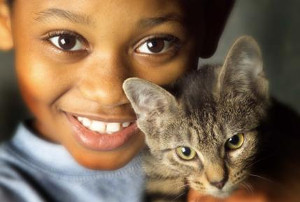Helping Children Deal with Pet Loss

Grief is the normal and natural reaction when a pet has died. Everyone, including children perceives loss differently. Grief is a very personal and unique experience. One of the most difficult tasks for grieving children is to learn how to incorporate the death of a pet into their life and to figure out how to go on living without them.
Regardless of their age, children can experience shock, denial, confusion, sadness, anger, blame, withdrawal, wishing, acceptance and healing after a pet dies. Keep in mind that children grieve differently at different ages. Younger children do not understand that death is final, sometimes not until the ages of nine or ten years. It is important that adults support children based on their individual needs as well as each child's unique ability to comprehend the finality of death. The younger the child, the more confusing the finality of death can be.
It is important to be honest with children, but remember, that sometimes less information is better. Do not tell you child that you sent their pet away, when it has actually died. You could gently let children know that his pet's body was badly hurt in an accident and that its body cold not be fixed or that her pet's body stopped working. Parents are often confused about how to explain when a pet is "put to sleep". You could use this term with children, but remember to explain the difference between death and sleep and that their pet will not be coming back.
It not necessary to try to make your child believe that death is final. Understand that acquiring this information is a natural developmental process that happens when your child is ready to accept it. You may even notice that it may seem like your child fully understands that death is final, only to be surprised a few weeks later to learn that they do not. This is perfectly normal.
Believe in your child's ability to create a meaningful goodbye for their pet. Encourage them to make a special goodbye picture, write a letter to their pet or to have a special funeral or memorial service for their beloved pet.
1.Draw a picture about your pet. Have your child tell you about his/her picture.
2. Document funny stories and special memories.
3. Gather together pictures for a scrapbook or journal.
4. Buy a headstone or decorate a rock to place at the burial site.
5. If your pet is cremated, involve your child in the decision about where to scatter or place the ashes.
6. Create a memory box.
7. Decorate the outside.
8. Place inside special momentos, a dog tag, toy, etc...
9. Plant a tree or bush in memory of your pet, especially in an area outside that your pet enjoyed.
10. Donate money to an animal related charity in memory of your pet.
by Cindy Clark
